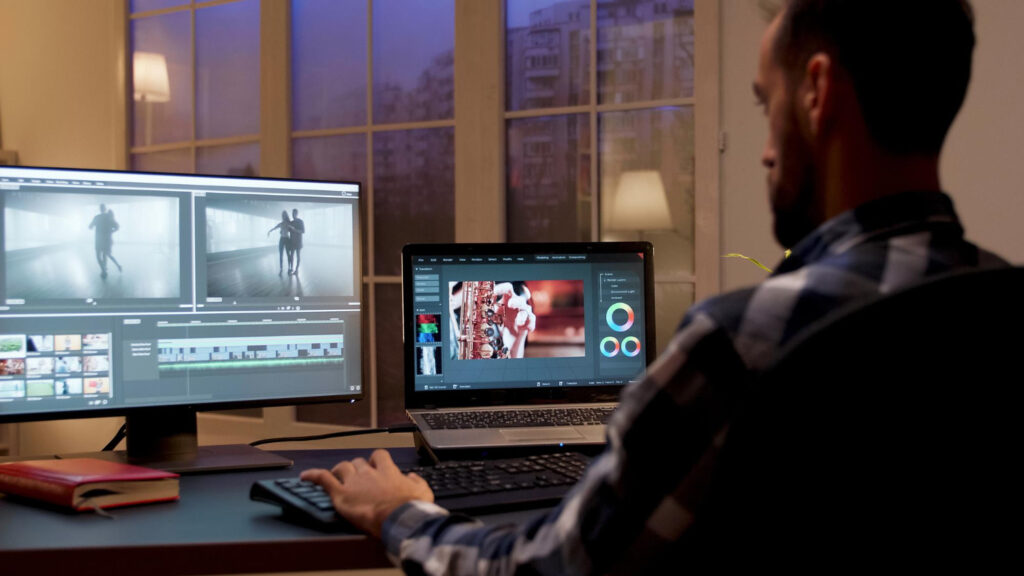M+E Europe

M&E Journal: Mitigating the Impact of Change
Story Highlights
There are several market-changing factors facing media and entertainment. Filmmakers face pressures due to significant cost inflation in key areas of production.
The burden on producers has grown acute after a decade of cheap debt, with the wage inflation associated with scarce talent exacerbating the effects. Crew shortages at all levels pose a threat to the sector, with indies struggling to compete with larger international productions.
Technology can mitigate the effects of some of these pressures, but hurdles remain. Here are a few key trends to keep in mind as we navigate towards the future.
 REMOTE COLLABORATION SAVES REAL MONEY WITH TRIED AND TESTED TOOLS AND WORKFLOWS
REMOTE COLLABORATION SAVES REAL MONEY WITH TRIED AND TESTED TOOLS AND WORKFLOWS
Remote collaboration slashes the cost of travel and accommodation from the estimated 30 percent cost to every production.
The tools to enable remote content collaboration are battle-hardened and will only get better.
Decisions about hybrid or entirely remote editorial are now embedded into discussions at the point creatives on-board a project, offering a better work-life balance.
The benefits are not all one way. Certain creatives (showrunners, directors) want their editor close to set, even during principal photography.
Reading the room with all its nuances in gesture and mood is something that remains tricky if not impossible to replicate when video streaming.
Therefore, workflows should still support in-person collaboration when appropriate.
VIRTUAL PRODUCTION IS ACCELERATING — BUT CREATES ITS OWN TIME AND COST CHALLENGES
Virtual production (VP) offers significant savings on travel, and subsequently on carbon footprint. As volume stages crop up everywhere to satisfy the demand to shoot locally, they are often booked out as soon as they launch.
VP is also the fastest developing area in our industry, although the techniques and best practices are still emerging.
 While the crew tasks and skill sets required for a VP shoot may differ to conventional production, the actual number of crew involved may not, in its current phase, be markedly different.
While the crew tasks and skill sets required for a VP shoot may differ to conventional production, the actual number of crew involved may not, in its current phase, be markedly different.
Consequently, the cost per day of shooting remains high for VP.
The complexity of virtual production needs to improve for it to become the first choice for production, with location shooting an aesthetic choice for those with the highest budgets or most prestigious creative talent.
However, capacity and pricing are impacting the decisions as much as the changes in pre-production required to be successful in this creative approach.
CLOUD WORKFLOW ADOPTION REMAINS HAMPERED
The ability to push raw original camera files (OCF) from set to cloud for instant access by creative talent anywhere will bring sweeping benefits to production, condensing time scales and enabling real-time geographically dispersed creative collaboration.
However, we’re not there yet! Proxy streams speed editorial and shot reviews, but only true OCF pushed from set to cloud can truly revolutionise post.
There are still cost challenges to tackle. Migration to public cloud workflows is still slow, with larger scale projects finding end-to-end cloud production problematic to manage on top of exorbitant penalties for egress between cloud providers.
Studios would like their productions to be able to hop seamlessly from provider to provider, following the sun, taking advantage of economies of scale to render creative vision across multiple cloud providers, but such workflows remain stymied.
AI, ML AND CHATGPT PROMISE PRACTICAL BENEFIT AND A RADICAL FUTURE
The automation of workflows and jumpstarting the creative process using artificial intelligence/machine learning (AI/ML) are fast entering the equation.
 AI/ML is already in the wild all over the industry, and media companies are adopting AI tools for everything from storyboarding in pre-production to streamlining asset management and powering search and recommendation engines for service subscribers.
AI/ML is already in the wild all over the industry, and media companies are adopting AI tools for everything from storyboarding in pre-production to streamlining asset management and powering search and recommendation engines for service subscribers.
AI is already proficient at tackling time-consuming tasks like de-noising, rotoscoping, and motion capture tracking removal.
Footage restoration, colourisation, categorisation, facial recognition, and metadata enhancement are other areas that AI/ML can tackle effectively in the near-term.
STREAMERS CUT THEIR CLOTH TO LOOK LIKE TV
The squeeze on cost of living translates into constant cancellation or rotation of streaming services and has caused major SVODs to rush to offer cheaper ad-supported alternatives. The goal for most is to reduce churn and increase revenues to sustain multi-billion-dollar content costs without decimating the existing linear TV and cable subscriber base, while the hard-core streamers (Apple, Amazon, Netflix) have no legacy revenue streams to protect.
Netflix estimated 7.7 million unique viewers for its Basic with Ads tier by the end of 2022 and anticipates this tier could generate $1.9 billion in ad revenues by 2027 in Western Europe alone. Virtually everyone agrees Netflix’s ad play will be successful.
But will getting into advertising change the brand and DNA of a company which has closely guarded its own data and prided itself on forging a distinct path in the cutthroat world of entertainment?
The shift from pure SVOD into ads brings streaming TV closer to broadcast TV models. The popularity of linear free ad-supported TV (FAST) channels is another move in this direction, as is the shift toward aggregation.
Consumers prefer one place to access live sports, music, gaming and news alongside premium TV and film.
While Netflix has bolstered its gaming division, the other tech giants are jostling to bundle an array of digital entertainment in one place.
 The major difference between broadcast and streaming remains interactivity.
The major difference between broadcast and streaming remains interactivity.
Expect applications utilising ultra-low latency at the network edge such as gaming and VR to begin to take off from 2023.
As the industry moves past the pandemic, charts the course of the large-scale return to the cinema, and fights for the hearts and eyes of audiences, the challenges facing entertainment companies are not just to thrive but, in some cases, to survive.
While the domestic box office in 2022 is expected to land around $7.8 billion which is up from 2021, it’s still 35 percent less than 2019.
The economic impact of WFH may not be the overall solution, but it does offer creative and financial opportunities that will play a critical role in the delivery of content as well as an improved work-life balance for most creatives and support teams in our industry.
* By Chuck Parker, CEO, Sohonet *
=============================================
Click here to download the complete .PDF version of this article
Click here to download the entire Winter 2022 M&E Journal









